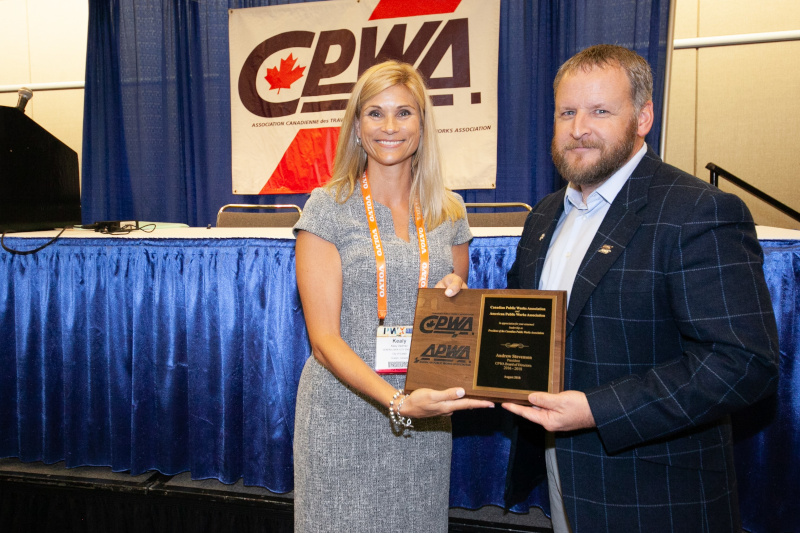Canadian Public Works Association (CPWA)
A tradition of service
Business View Magazine highlights the Canadian Public Works Association (CPWA) for our focus on Infrastructure and Essential Services
The Canadian Public Works Association (CPWA), or Association Canadienne des Travaux Publics, was founded in 1986 to enhance the services of the American Public Works Association (APWA) to the Canadian public works community. Since that time, CPWA has become “the voice of public works in Canada.” APWA was formed on January 1, 1937 and now has 63 chapters in North America. In addition to its eight Canadian chapters, APWA has demonstrated its commitment to international linkages through the strengthening of relationships with public works officials in Australia, New Zealand, Mexico, Finland, Sweden, Norway, Denmark, Iceland, and the Czech and Slovak Republic.
As public works services become more complex and the skills required to deliver them become more diverse, APWA continues to position itself to respond to these changes and the needs they identify. Building on the tradition of service to the public works profession, APWA will meet the challenges of being THE comprehensive public works resource in the 21st Century.
This year, APWA released a three-year strategic plan with the following strategic goals:
- Value: Promote the value of public works and enhance its visibility and awareness
- Voice: Be the voice of public works to government leaders, the public, and media
- Education & Credentialing: Provide excellence in education and credentialing
- Membership and Chapters: Deliver an outstanding and valuable membership experience in collaboration with Chapters
Membership
With a worldwide membership more than 30,000 strong (over 2250 in Canada), APWA includes personnel from local, county, state/province, and federal agencies, as well as private sector personnel who supply products and services to those professionals. Membership is open to any individual, agency, or corporation with an interest in public works and infrastructure issues. APWA has two types of membership: Individual Membership includes Student, Retired and Life Members; Group Membership includes Public Agency Groups, One-Call Center/System Groups, Corporate Groups and Student Groups.
The Association’s monthly publication – APWA Reporter – serves as the prime communication link for members, in addition to websites, YouTube, Facebook, twitter, Instagram and LinkedIn, and e-newsletters, including the weekly update ‘In the Works,’ the weekly Washington Report government affairs update, and the bi-weekly Ottawa Report government affairs update. APWA also maintains numerous online networking communities that facilitate communication among members and staff through topic-based groups, discussion boards, working groups and committees.
Sustainability
Public works leaders have been in the business of sustainability for as long as there has been a need to manage public infrastructure and services. In establishing the APWA Center for Sustainability (C4S), the APWA Board of Directors recognized that many challenges currently facing public works professionals – changes in the cost and availability of key resources and critical materials; changing social attitudes with regard to environmental protection; shrinking public funding; and new and changing operating conditions brought about by a changing climate and extreme weather events – can be addressed with a sustainable approach that accounts for economic, environmental and social impacts.
To that end, the APWA Center for Sustainability (C4S) has developed a set of guiding principles to help public works leaders identify the actions they can take to integrate the concepts of sustainability into their organizational objectives and operations.
APWA’s Principles of Sustainability:
- Recognize the Community as an Interconnected System
- Promote Community Revitalization
- Manage Assets
- Restore and Enhance the Natural Environment
- Protect and Enhance Recreational and Heritage Resources
- Collaborate with Key Stakeholders
- Practice Fiscal Responsibility
- Foster Active Communication and Civic Engagement
Some illustrations of these principles in Canada:
The Town of Raymond, Alberta, powers nine municipal buildings and all of its street lights with 729 kW of solar panels installed with help from a grant obtained through the Municipal Climate Change Action Centre. The panels are currently leased from Calgary power utility Enmax, but when the 15-year lease expires, the town will own its own power utility.

The City of Calgary, with help from the Government of Alberta, has undertaken numerous projects to improve flood resilience since severe flooding in 2013. Projects include upgrades to the Glenmore Dam, Bonnybrook Wastewater Treatment Plant and Roxboro Sanitary Lift Station, as well as adding new pump stations, stormwater outfall gates and flood barriers.
The Town of Gibsons, British Columbia, established a municipal asset management policy that defines and recognizes the value of natural assets and creates specific obligations to operate, maintain and protect natural assets alongside traditional capital assets. The town determined that its woodlands, creeks and ponds provide the vital service of conveying and treating rainwater run-off. In order to maintain these services, the town paid $45,000 for an initial assessment and $15,000 for general maintenance and pond dredging every three years. In contrast, providing the same stormwater management services through engineered assets were estimated to cost 3.5 to 4 million dollars.
In Manitoba, Fisher River Cree Nation’s utility-scale solar farm provides revenue for the community while also helping community members develop specialized skills. The project was designed and managed by an Indigenous-owned firm that specializes in solar, wind and renewable energy systems, and construction included members of Fisher River Cree Nation. An agreement with Manitoba Hydro enables Fisher River to sell the energy generated by the array to the energy utility.
The City of Toronto is taking a proactive and targeted approach to enabling safe transportation access for all users, including pedestrians, bicyclists, motorists and transit riders of all ages and abilities. The city has adopted a Complete Streets Policy, a Vision Zero Road Safety Plan and a Cycling Network Plan. By widening sidewalks, reducing vehicle lane widths, reducing speed limits and adding bicycle lanes, the city seeks to give users more options and eliminate serious injuries and fatalities.
The City of Saskatoon, Saskatchewan is applying new products and techniques to roadway construction, using treatments such as crack sealing and micro surfacing to extend the life of the roads. The city is using a rubber asphalt repair material that expands and contracts with the road to create a better seal that prevents the infiltration of water. Crews are also using a new technique to penetrate more deeply into cracks, making repairs more resilient.
In Quebec, a coalition of municipalities located outside urban centres is adding electric vehicles to their municipal fleets along with charging stations for public use. A car sharing program allows the vehicles, when not being used by city staff, to be reserved by residents who face a lack of public transit options.
In 2018, the City of Vancouver, B.C. launched its first green bond offering of $85 million to fund environmentally sustainable initiatives and projects, while offering investors competitive returns. Eligible capital projects include investments in renewable energy, energy efficiency, green buildings, clean transportation, pollution prevention and control, sustainable water and wastewater management, and environmentally sustainable management of living natural resources.
Overcoming challenges
Decades of diminishing public investment in infrastructure in the latter half of the 20th century led to a decline in the physical condition of local infrastructure and an increase in the cost of renewing aging assets. During the financial crisis of 2007–08, governments pooled resources and cooperated to channel stimulus funds into local infrastructure, creating jobs while also renewing the physical foundations of the economy. The importance of investing in modern infrastructure has become synonymous with economic competitiveness and quality of life.
In 2012, with this context in mind, CPWA, APWA’s advocacy arm in Canada, partnered with the Canadian Construction Association, Canadian Society for Civil Engineering and Federation of Canadian Municipalities to create the first Canadian Infrastructure Report Card (CIRC). The CIRC was created to establish a rigorous, repeatable process for assessing the health of Canada’s infrastructure and to inform Canadians, policymakers and other stakeholders about issues and trends. This objective assessment demonstrated the need for national efforts to assess the condition of all infrastructure; to determine investment needs based on that assessment and accepted standards; and to make infrastructure investments in the most efficient and cost-effective way possible.
In 2016, the Government of Canada announced the Investing in Canada plan, based on creating long-term economic growth, supporting a low carbon green economy, and building inclusive communities. The Investing in Canada plan encompasses more than $180 billion of investment over 12 years in five main infrastructure priorities: public transit, green infrastructure, social infrastructure, trade and transportation, and rural and northern communities.

2018 CPWA Past Presidents Dedman and Stevenson
In 2017, Statistics Canada launched Canada’s Core Public Infrastructure (CCPI) survey to collect data from municipalities. Developed by Infrastructure Canada and Statistics Canada, the CCPI survey provides a national snapshot of the stock, condition and performance of public infrastructure across Canada. The need for investment in and timely assessment of the condition of public infrastructure is ongoing, and the CIRC has been an important contribution to the national conversation.
Success Stories
The principles of sustainable development are fundamental to how civil engineers and the public can more successfully address critical societal needs, environmental pressures and climate change impacts, and the return on investment in infrastructure. This led APWA to partner with the American Council of Engineering Companies (ACEC) and the American Society of Civil Engineers (ASCE) to launch a not-for-profit organization dedicated to sustainable infrastructure, the Institute for Sustainable Infrastructure (ISI). ISI’s sustainability rating tool, Envision, is a holistic framework for evaluating and rating the community, environmental and economic benefits of all types of infrastructure projects. Envision also recognizes infrastructure projects that use transformational, collaborative approaches to assess sustainability indicators over the course of a project’s life cycle.
Since ISI was established in 2010, 83 infrastructure projects have been verified and another 90 projects are registered or in verification, collectively representing $23 billion (USD) in value. Projects range from water treatment plants and wastewater treatment facilities, to roads and bridges, to parks and airports. In addition, 230 companies and 100 government agencies are members of ISI and 6,000 individuals are active credentialed Envision Sustainability Professionals.
Looking ahead
In an age where technology advances at an exponential pace, public works departments are constantly finding new ways to bring safety, economy, sustainability and service to their communities. To help members stay in-the-know about industry-changing endeavors, APWA began the Top 5 Trending Technologies survey and report in September 2018.
APWA’s Top 5 Trending Technologies for 2020 are:
- Automated/Connected Vehicles
- Waste to Resource Technology
- Technology for Field Crews Including GIS
- Cybersecurity for Critical Infrastructure
- 3D Technologies
These trending technologies, like others identified in past years, such as Geographic Information System (GIS)/Mapping, Unmanned Aircraft Systems (UAS)/Drones and Global Positioning System (GPS)/Automatic Vehicle Location (AVL), are changing not just the way public works professionals do their jobs – in some cases they are changing what jobs public works professionals do.
In another recent initiative, APWA is building awareness of the role of public works professionals as first responders. At the local level, public works professionals are responsible for many aspects of emergency planning and disaster response, including assessing damage to buildings and infrastructure; clearing and disposing of debris; removing snow in blizzard conditions ahead of police and fire services; securing critical facilities and restoring lifeline services; managing traffic and coordinating municipal vehicles, equipment and manpower; and ensuring a safe public water supply.
In 2017, APWA announced the creation of a national “Public Works First Responder” symbol for use throughout North America to identify public works personnel and acknowledge their role as first responders. Public works agencies are displaying the symbol to raise awareness among all citizens, government officials, and other first responders about the critical role public works plays in emergency management efforts.
Public works is the combination of physical assets, management practices, policies, and personnel necessary for government to provide and sustain structures and services essential to the welfare and acceptable quality of life for its citizens. Public works services may not be readily identified on a city organizational chart, or delivered in the same way, or to the same level, from one community to the next. But whether or not we ‘see’ and recognize the city engineers, property superintendents, utility managers, park directors, waste collection crews, snow plow drivers and others that encompass public works, our way of life would be radically altered without them.
This is why each year since 1960, APWA has sponsored National Public Works Week during the third week in May. Across North America, APWA’s more than 30,000 members in the U.S. and Canada use this week to energize and educate the public on the importance of public works to their daily lives.
AT A GLANCE
Canadian Public Works Association (CPWA)
What: The Canadian arm of the American Public Works Association (APWA)
Where: Ottawa, Ontario
Website: www.cpwa.net and www.apwa.net


